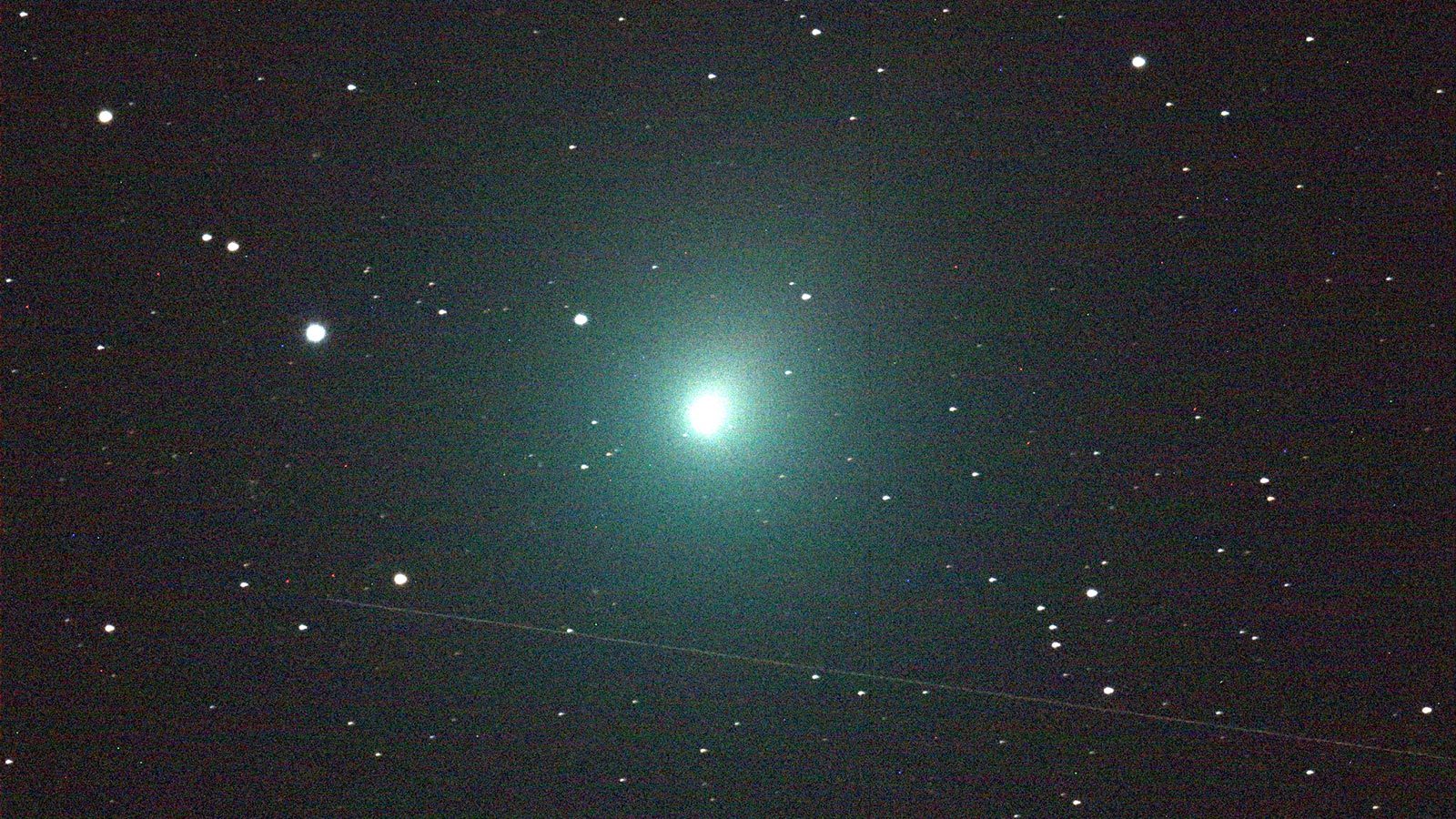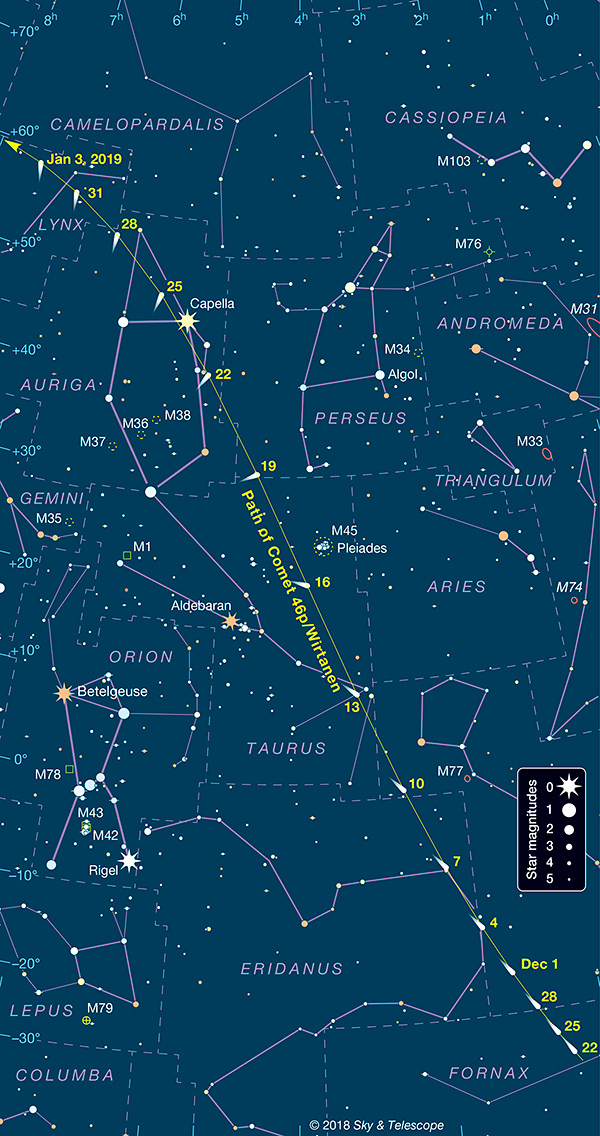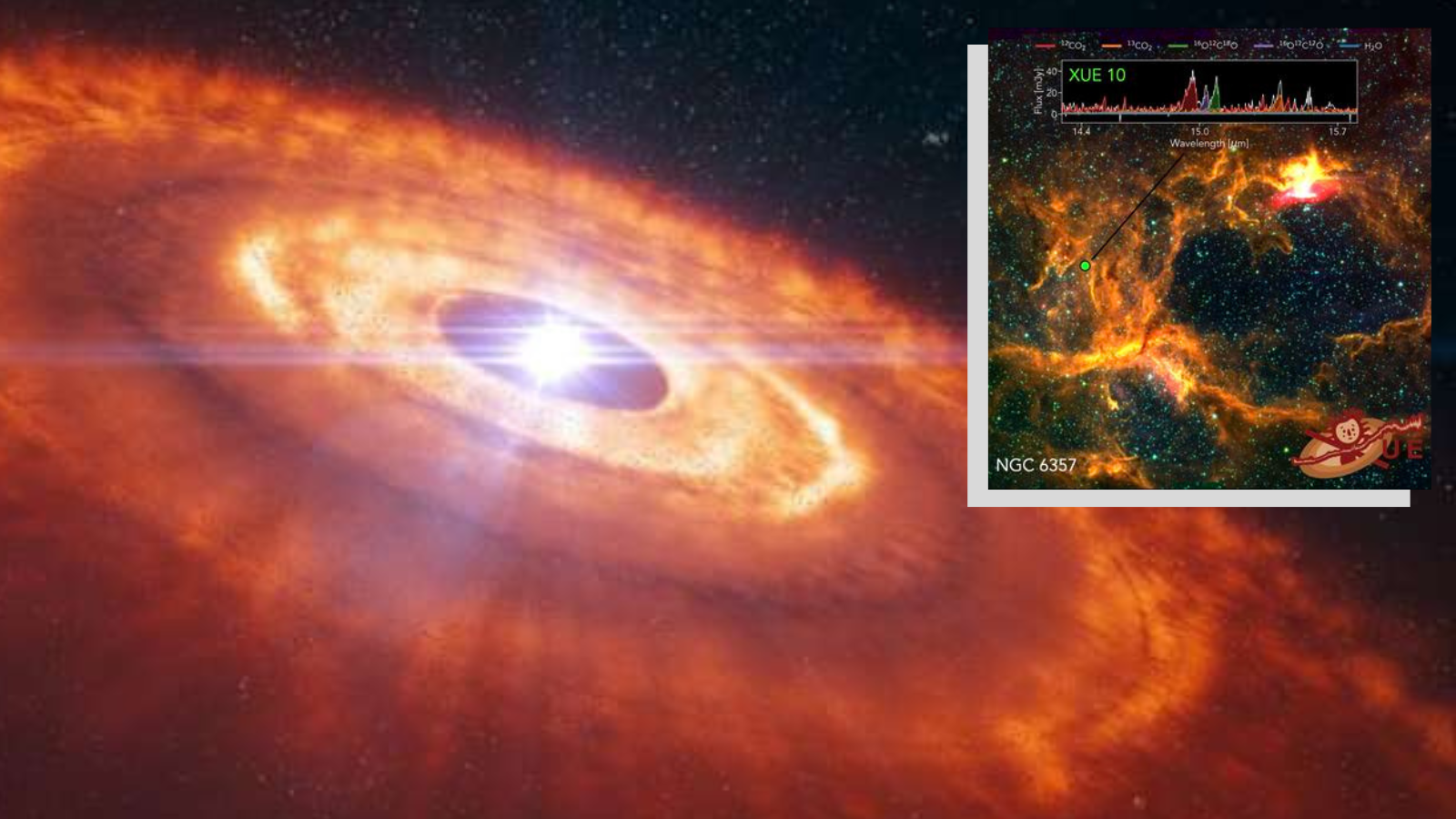How to See Ghostly Green Comet 46P/Wirtanen Fly by Earth This Weekend
You can expect a ghostly green blob to grow brighter in the sky near Orion in the coming days, as Comet 46P/Wirtanen makes it closest approach to the Earth in 20 years this weekend.
Shining just bright enough to be glimpsed with the naked eye, this fuzzy visitor of ice and rock will be easily visible through late December. NASA has even sponsored an observing campaign (led by the University of Maryland) to track the comet with professional and amateur astronomical groups.
The comet will make its closest approach on Sunday (Dec. 16), flying by just 7,199,427 miles (11,586,350 kilometers) from our planet. That's about 30 times the distance to the moon. It sounds far away, but in celestial terms, this is a close flyby — among the 10 closest cometary approaches since 1950, according to Space.com skywatching columnist Joe Rao. If you're worried about dangerous comets striking Earth, however, breathe easy: Wirtanen is not on the list of those that astronomers worry about. [Amazing Photos: Brilliant Comet 46P/Wirtanen Wows Stargazers]
"This will be the closest comet Wirtanen has come to Earth for centuries and the closest it will come to Earth for centuries," Paul Chodas, manager of NASA's Center for Near-Earth Object Studies at the Jet Propulsion Laboratory in Pasadena, California, said in a statement. "This could be one of the brightest comets in years, offering astronomers an important opportunity to study a comet up close with ground-based telescopes, both optical and radar."

Right now, Australian National University astronomer Brad Tucker told Space.com, Wirtanen is "hanging out near the constellation Orion," which, luckily, is an easy find for even a beginning astronomer. Orion is a bright wintertime constellation that you can spot in the eastern sky by the distinctive "Orion's Belt," a band of three stars.
If you hold your fist to the sky and look a couple of fist-lengths to the right of the belt, you will spot Wirtanen. This article by Rao gives you more details about where to look, depending on when you are able to go outside for the show.
Wirtanen's unusual composition (it includes methane and carbon), as well as its close orbit to the sun, made it the original target for the European Space Agency Rosetta mission. However, Rosetta's target was changed to Comet 67P/Churyumov-Gerasimenko, which the probe studied for roughly two years, between 2014 and 2016.
Breaking space news, the latest updates on rocket launches, skywatching events and more!
Science aplenty

Wirtanen is one of three comets that astronomer Carl Wirtanen discovered in 1948. It makes flybys of Earth every 5.4 years, cycling in a short orbit that makes it a part of the Jupiter-class family of comets. (By contrast, comets from the distant Oort Cloud, located past Neptune, may have orbital periods spanning decades, or even hundreds or thousands of years.)
These constant swings by the sun come with a cost. Wirtanen is largely made up of ices, and with the comet's repeated passes by our star, that ice has bled off over the eons — eliminating any hope of a bright tail caused by lots of material released at once, Tucker said. Also, Wirtanen has a small nucleus. The Hubble Space Telescope examined Wirtanen in 1996 and found a tiny core of only seven-tenths of a mile (1.1 km), one of the smallest cometary nuclei we know of.
So, the comet will not be that bright in the night sky, but researchers can still perform valuable science as the object flies by Earth, Tucker said. Looking at the radio-range wavelengths of light the comet releases, astronomers can examine the distinctive gases that come off of the visitor. Wirtanen stands out among comets because its surface contains a lot of methane and carbon, as well as the usual water ice. While the reason for this composition is poorly understood, scientists know for sure that the water and the methane give Wirtanen its green coloring.
NASA is pulling out all the stops for the comet's close flyby.
"NASA-sponsored ground, air and space-based observatories getting in on the action include NASA's Goldstone Solar System Radar in California; the NASA Infrared Telescope Facility on Maunakea, Hawaii; the Hubble, Chandra, Swift and Spitzer space telescopes; and an airborne observatory known as the Stratospheric Observatory for Infrared Astronomy (SOFIA)," NASA officials wrote in a statement. " The comet will even pass through the observing field of the Transiting Exoplanet Survey Satellite (TESS)."
You can follow the project, called the Comet Wirtanen Observing Campaign, at its website here: http://wirtanen.astro.umd.edu.
Radar telescopes can also look at the core of the comet to better understand its rotation rate and direction of spin. Because passing by Jupiter perturbs the comet, astronomers know that its trajectory has changed over the years; specifically, Wirtanen had two close brushes with Jupiter, in April 1972 and February 1984, that moved the comet's orbit 50 million miles (80.5 million kilometers) closer to the sun, as well as closer to Earth's orbit, Rao said in his article.
Scientists still don't know how Wirtanen came to be — if it used to be an Oort family comet that was perturbed into moving closer to Jupiter or if it broke off from a larger body in the past, Tucker said. But the comet is an interesting object of study and helps astronomers better understand comets in general, especially those that are a part of the Jupiter family.
Editor's note: If you snap an amazing photo of Comet 46P/Wirtanen that you'd like to share with Space.com and our news partners for a possible story or image gallery, send comments and images in to: spacephotos@space.com.
This article was corrected to indicate that the comet is to the right of Orion, not to the left.
Follow us on Twitter @Spacedotcom and on Facebook. Original article on Space.com.
Join our Space Forums to keep talking space on the latest missions, night sky and more! And if you have a news tip, correction or comment, let us know at: community@space.com.

Elizabeth Howell (she/her), Ph.D., was a staff writer in the spaceflight channel between 2022 and 2024 specializing in Canadian space news. She was contributing writer for Space.com for 10 years from 2012 to 2024. Elizabeth's reporting includes multiple exclusives with the White House, leading world coverage about a lost-and-found space tomato on the International Space Station, witnessing five human spaceflight launches on two continents, flying parabolic, working inside a spacesuit, and participating in a simulated Mars mission. Her latest book, "Why Am I Taller?" (ECW Press, 2022) is co-written with astronaut Dave Williams.
